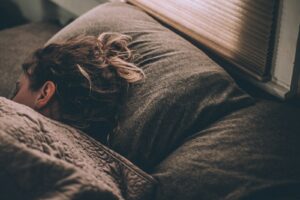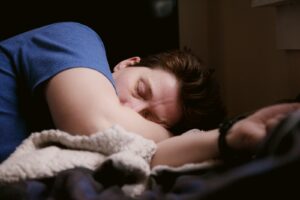Why Sleepmaxxing Could Prove A Nightmare When Trying To Get A Perfect Night’s Rest

A sleep expert is warning people to be careful of ‘advice’ on social media targeted at helping people sleep.
The social media trend of ‘sleepmaxxing’ is growing in popularity, with hundreds of videos on TikTok from influencers sharing their sleep hacks aimed at better sleep quality and quantity.
Put simply, sleepmaxxing is about optimising both the quality and quantity of sleep by using various techniques, routines and even gadgets to ensure a more restful and restorative sleep.
But Martin Seeley, senior sleep expert from MattressNextDay has revealed that some of the suggestions being shared are dangerous and could lead to complications.
Instead, Martin recommends people suffering with poor sleep follow proven techniques which don’t come with potentially dangerous side effects.
“Sleepmaxxing is, as the name suggests, about maximising your sleep quality,” he says.
“Sleep is essential to both our physical and mental health, so it is great that there is a renewed focus on its importance.
“Sleepmaxxing could include lifestyle changes like adjusting your sleep environment or introducing a routine before bed, but social media is also recommending other ‘hacks’ including apps and devices.
“But just like you shouldn’t get advice on a health condition from social media, the same applies for sleep. It’s a science and a dedicated branch of medicine.
“There are lots of proven ways to help improve your sleep, many of which can be found on my own sleep blog [link] but if you are struggling with sleep more often than not, it is important that you consult a health professional.
“Conditions such as obstructive sleep apnoea have health risks which go beyond feeling tired and poor sleep overall can cause other health conditions including diabetes and poor mental health.”
Sleep ‘hacks’ to avoid
- Mouth taping
Another TikTok trend linked with sleepmaxxing is mouth taping. This is exactly as it sounds – taping the mouth shut when you sleep.
The idea behind this is to encourage nasal breathing, with proponents claiming benefits like improved sleep quality and reduced snoring. Nasal breathing also prevents a dry throat and mouth and allows air breathed in through the nose to be filtered for allergens, dust and pollutants.
“Scientific evidence is limited for the benefits of nasal breathing, but what is known is that mouth taping can be dangerous,” says Martin.
“One of the leading causes of snoring is obstructive sleep apnoea (OSA) because the muscles in your throat relax too much when you sleep, causing the airway to narrow or collapse. In order to prevent suffocation you breathe in through your mouth, but often your brain also jolts you awake.
“Breathing through your mouth is an important backup, as anyone who has a cold will know. If you can’t breathe through your nose when you sleep your mouth will naturally open.
“But if you’ve taped your mouth shut it could be impossible to do this. You could end up with reduced oxygen levels which is extremely dangerous.
“Instead of taping your mouth shut to reduce snoring, you should find out whether you have OSA with a formal diagnosis.”
2.Nostril expanders
While nostril expanders like nasal dilators or strips can potentially help with snoring and improve nasal airflow, there are potential risks. These include skin irritation, discomfort, and in some cases, dependence on the device.
“Nasal strips, especially those with adhesive, can cause skin irritation, redness, or itching beneath the strip,” says Martin.
“There is also the risk of them causing irritation and dryness on the inside of your nose, leading to discomfort, an increased risk of nosebleeds and even sinus problems.
“Our nostrils are designed to help catch particles such as pollutants and allergens and widening the nostrils can reduce the effectiveness of this process which evolution has designed.
“They can also cause you to have a runny nose, which can lead to worse sleep.”
- White noise
White noise is a continuous background noise which contains a mixture of all audible frequencies, creating a ‘static-like’ sound.
It is primarily used to drown out other potentially disruptive sounds in your environment. Our brains are on alert for changes in sounds rather than continual noise, which is why the constant rumble of traffic might not disrupt your sleep but a barking dog can.
White noise is processed by the brain in the same way as other sounds but it is not classed by your brain as a significant melodic tone or noise, making its monotonous hum a good combination of boring yet calming.
“White noise can be particularly good for people who have insomnia,” says Martin. “Think of it as a clean, white sheet for your ears that blocks out all other noise disturbances.
“But it isn’t for everyone, as it emphasises high-frequency sounds which can be too noisy for some people.
“Many people also use a fan for their white noise, with the coolness as a nice side effect, but this does come with downsides particularly if you suffer from allergies or asthma. This is because an electric fan will also circulate dust mites, spores, pollen and other allergens.
“A fan can also dry out your nose and throat, leaving your body at risk of dehydration and with other side effects including headaches, stuffy nose and sinus problems.
“A fan running all night can also cause a stiff neck and sore muscles as the cool air causes the muscles to tense and cramp.”
Image Source: Unsplash





